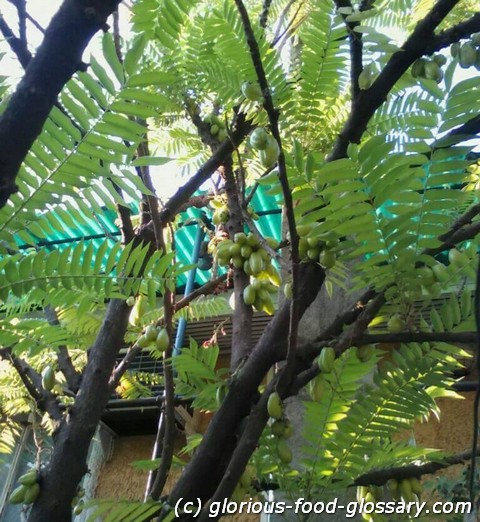Deutsch: Kamias-Baum / Español: Árbol de Kamias / Português: Árvore de Kamias / Français: Arbre de Kamias / Italiano: Albero di Kamias
Puno ng Kamias refers to the tree bearing kamias (Averrhoa bilimbi), a tropical fruit native to Southeast Asia, including the Philippines. The kamias tree is known for its small, cucumber-shaped fruits that range from green to yellowish-green when ripe. These fruits are famous for their extremely sour taste and are often used in Filipino cuisine as a souring agent in dishes, such as sinigang (a sour soup or stew), or made into preserves, candies, and even vinegar.
Description
The kamias fruit, coming from the puno ng kamias (kamias tree), is integral to the culinary traditions of the Philippines and other Southeast Asian countries. The tree itself is medium-sized, growing abundantly in the tropical climate of the Philippines. The sourness of kamias comes from its high citric acid content, making it an excellent natural souring agent in cooking, providing a distinct flavor profile that cannot be easily replicated with other ingredients.
Application Areas
Kamias is primarily used in cooking, especially in Filipino dishes that require a sour flavor. It's a popular ingredient in sinigang, a staple Filipino soup known for its sour broth, where kamias serves as an alternative to tamarind to achieve the dish's characteristic tanginess. Beyond soups, kamias can be used in marinades to tenderize meats or turned into refreshing drinks, jams, and sweets, showcasing its versatility in both savory and sweet preparations.
Well-Known Examples
Aside from sinigang, kamias is used in other traditional Filipino dishes. One example is paksiw na isda, a dish where fish is simmered in vinegar and water, with kamias adding a unique sour note. Kamias can also be sun-dried and stored for long periods, making it a valuable ingredient in Filipino kitchens for adding a sour taste to dishes, even out of season.
Treatment and Risks
Kamias is not only prized for its culinary uses but also for its medicinal properties. It has been traditionally used to address various ailments, such as coughs, itches, and swelling. However, like all fruits, it should be consumed in moderation, especially by those who may have acid sensitivity or stomach issues, as its high acid content can cause discomfort for some individuals.
Recipes
Ingredients:
- Wash the kamias fruits thoroughly and slice them into thin pieces.
- Boil the sliced fruits in water until they soften and the water takes on a sour flavor, about 10-15 minutes.
- Strain the mixture, discarding the solid parts. Allow the juice to cool.
- Sweeten the kamias juice with sugar or honey according to taste.
- Serve the juice over ice cubes for a refreshing drink.
Similar Terms or Synonyms
Kamias is also known as bilimbi, cucumber tree, or sour cucumber in English. It is related to the carambola or starfruit but is distinguished by its sour taste and smaller, cucumber-like appearance.
Summary
Puno ng Kamias is more than just a fruit-bearing tree in the Philippines; it is a source of a versatile ingredient that spans the spectrum of Filipino cuisine, from sour soups to sweet preserves. Kamias embodies the Filipino culinary tradition's ingenuity, turning a fruit with a potentially overpowering sourness into a beloved component of many dishes. Its usage reflects the broader Southeast Asian practice of using natural, locally available ingredients to create dishes with rich, complex flavors.
--

Related Articles to the term 'Puno ng Kamias' | |
| 'Kamias' | ■■■■■■■■■■ |
| Kamias is a Filipino fruit with scientific name Averrhoa bilimbi. The fruit is green and edible, about . . . Read More | |
| 'Sampalok' | ■■■■■■■■■ |
| Sampalok is a Filipino word for Tamarind. In the Philippines its pulp/fruit are eaten and used as a souring . . . Read More | |
| 'Batwan / Batuan' | ■■■■■■■■ |
| Batwan / Batuan: Batwan refers to a green sour fruit which is used as a souring agent for making Sinigang . . . Read More | |
| 'Sinigang na Baboy' | ■■■■■■■ |
| Sinigang na Baboy is a classic Filipino dish known for its sour and savory flavors, primarily featuring . . . Read More | |
| 'Batuan' | ■■■■■■■ |
| Batuan is a tropical fruit primarily used as a souring agent in Filipino cuisine. This small, green fruit . . . Read More | |
| 'Batwan' | ■■■■■■ |
| Batwan: Garcinia binucao is a species of flowering plant in the Clusiaceae family. It is commonly known . . . Read More | |
| 'Papaya (Hilaw)' | ■■■■■■ |
| Papaya (Hilaw) refers to the unripe, green papaya fruit commonly used in various culinary applications . . . Read More | |
| 'Batao' | ■■■■■■ |
| In the food context, \'Batao\' refers to a type of bean commonly used in Filipino cuisine, also known . . . Read More | |
| 'Bagoong Sisi' | ■■■■■■ |
| Bagoong Sisi (Sisi Bagoong) refers to fermented small oysters and clams which comes from the Visayas . . . Read More | |
| 'Pinangat na Galunggong' | ■■■■■■ |
| Pinangat na Galunggong is a Filipino culinary dish that features galunggong (round scad) cooked in a . . . Read More | |
